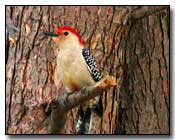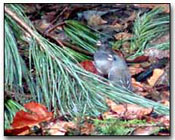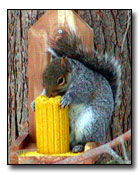|
Setting up your backyard properly will dictate the outcome of your bird and wildlife photography. Birds need food, water, shelter and nesting sites (if your yard is big enough to support nests). As long as you place the food and water in an optimum location for bird photography, you will have the opportunity for wonderful bird photographs.
Surveying Your Yard:
The best time to photograph birds is early in the morning and later in the afternoon because of the position of the sun. In fact, birds eat early in the morning and later in the afternoon so this is consistent will the sun's ideal position in the sky. On a bright sunny day, walk around your yard in the early morning and notice where the sun is shining and where there is a background that will enhance your photographs. Focus your camera on an object the size of the bird to see how close you have to be to be in order to fill the frame with the bird. By deciding in advance where the proper lighting is, where the best background exists, and where you have to stand will help in the composition of your bird photographs. Visit your yard in the afternoon to also see where the afternoon sun in shining. With any luck, you will be able to position your bird feeder and water in an area that works for both the morning and afternoon sun.
The Perch:
 Usually a bird will land on a perch for a few seconds before proceeding to the bird feeder. It may be due to other birds eating at the moment or just scouting the area to make sure that there are no predators nearby. Whatever the reason, the perch gives you an opportunity for bird photography. Before you decide on the placement of your bird feeder, see if there are natural perches available or if there is an area that you can create your own perch. The woodpecker is sitting on a perch that was cut from a dead branch. If the whole dead branch had been left, the bird probably would not stop there. Since it was cut short, birds almost always stop on the perch.
Usually a bird will land on a perch for a few seconds before proceeding to the bird feeder. It may be due to other birds eating at the moment or just scouting the area to make sure that there are no predators nearby. Whatever the reason, the perch gives you an opportunity for bird photography. Before you decide on the placement of your bird feeder, see if there are natural perches available or if there is an area that you can create your own perch. The woodpecker is sitting on a perch that was cut from a dead branch. If the whole dead branch had been left, the bird probably would not stop there. Since it was cut short, birds almost always stop on the perch.
Stacked Logs:
 Stacks of logs can also be used for a perch. In fact, a hole can be drilled into a log and filled with seed. The seeds will attract birds to the wood pile and a natural looking bird photograph will result. Experiment with both light and dark logs based on the colors of the birds that visit your yard. Remember that white colored logs may fool the camera meter, but at the same time, might be a background that accentuates the colors of a particular bird. You also might want to try turning the logs either parallel or perpendicular to your camera.
Stacks of logs can also be used for a perch. In fact, a hole can be drilled into a log and filled with seed. The seeds will attract birds to the wood pile and a natural looking bird photograph will result. Experiment with both light and dark logs based on the colors of the birds that visit your yard. Remember that white colored logs may fool the camera meter, but at the same time, might be a background that accentuates the colors of a particular bird. You also might want to try turning the logs either parallel or perpendicular to your camera.
Brush Pile:
 Broken white pine branches piled on top of each other create another nice area for birds to eat as well
as seek shelter. The white pine branches will also remain green for a very long period of time, especially in winter. A good time to gather white pine branches is after a heavy winter snow since many branches break due to the weight of the snow. Tossing seed in front or on top of the pile of pine branches will create opportunities for bird photographs. You can also stack dead piles of branches but sometimes the dead branches will interfere with the bird's legs when the bird is being photographed.
Broken white pine branches piled on top of each other create another nice area for birds to eat as well
as seek shelter. The white pine branches will also remain green for a very long period of time, especially in winter. A good time to gather white pine branches is after a heavy winter snow since many branches break due to the weight of the snow. Tossing seed in front or on top of the pile of pine branches will create opportunities for bird photographs. You can also stack dead piles of branches but sometimes the dead branches will interfere with the bird's legs when the bird is being photographed.
Feeder Placement:
Based on the lighting, the background, the perch and the distance from where you will photograph from, place your bird feeder in an area that meets these requirements. You might also be fortunate enough to be able to photograph from the inside of your house. The obvious advantage of being able to photograph from within your house is that you will not be seen by the birds too easily. Just remember any fast movement, whether you're outside or inside, will frighten most birds. Don't forget to purchase the correct bird seed for the birds in your area or all your planning will be of no use.
Making Friends With The Squirrels:
 Whatever steps you take to stop the squirrels from eating from your bird feeders will not succeed. They are extremely smart and will figure out how to eat from your bird feeders. The best way to solve the
squirrel issue is to place a squirrel feeder with corn-on-the-cob on a tree. One compressed corn is equal to about 10-12 individual corns so they last quite a while. If you don't find a sunny place for the squirrel feeder in the morning or late afternoon, don't be too concerned. The squirrels usually come around to eat during all times of the day as they are constantly looking for food. If the squirrels learn to trust you, you will be able to walk very close to photograph them.
Whatever steps you take to stop the squirrels from eating from your bird feeders will not succeed. They are extremely smart and will figure out how to eat from your bird feeders. The best way to solve the
squirrel issue is to place a squirrel feeder with corn-on-the-cob on a tree. One compressed corn is equal to about 10-12 individual corns so they last quite a while. If you don't find a sunny place for the squirrel feeder in the morning or late afternoon, don't be too concerned. The squirrels usually come around to eat during all times of the day as they are constantly looking for food. If the squirrels learn to trust you, you will be able to walk very close to photograph them.
In Summary:
Backyard photography is convenient as it brings the subject to you. Once you recognize the patterns of the birds and wildlife that visit your backyard, you will be rewarded with many backyard photography opportunities.
| 
